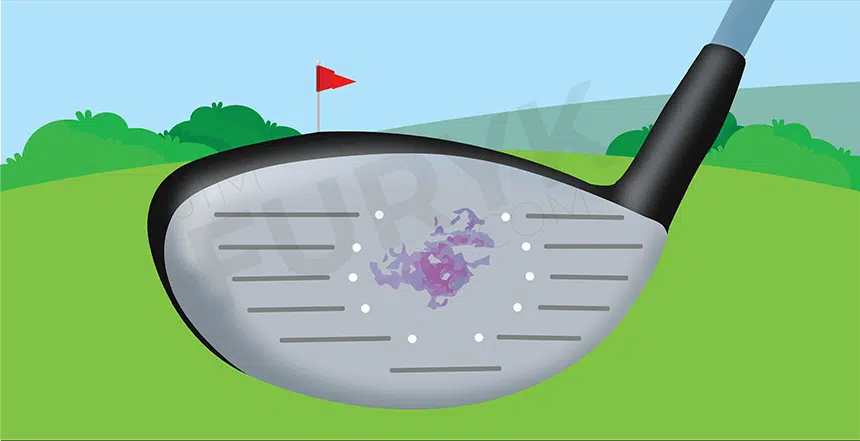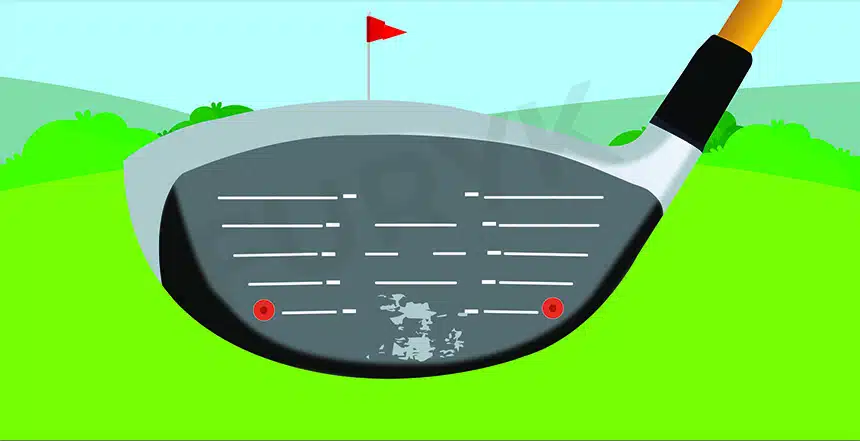Tee marks on bottom of driver – what is your golf driver trying to tell you?
The clubface may have a lot to say about the condition of the driver, so that’s what you should be checking first before anything else. Is the paint wearing off? Are there multiple impact marks you see in the upper section of that clubface? Sometimes when the golf balls you miss end up hitting the crown as well, which means you ought to inspect that too.
But our primary focus here is just one thing, and that is how to remove tee marks from golf driver. Whatever the cause or form of these impact marks, you should be able to get rid of them when you actually decide to stop procrastinating and get the job done!
One more thing, check the sole of your golf club as well. Typically, hitting up on the ball is what maximizes efficiency. So if you’ve been hitting down, it’s most likely that both the lettering and paint are being subjected to buffing off that sole. This has a lot to do with your angle of attack, which is something you can properly understand AND correct.
Circling back to tee marks on the driver…
In This Post
Why Are There Tee Marks On My Driver?

There’s absolutely nothing to worry about with tee marks because it’s just painting that has slacked off the tees. You obviously know that most tees out there are painted and the paint used is almost always low-quality and most likely to come off sooner than later.
Golf balls are placed on those tees, so you can hit more powerful, longer shots. And you hitting the ball positioned on the tee ‘harder’ certainly creates a heavy impact, which sometimes results in the tee paint (white in color and visible) coming off easily. It’s probably because of that very tee mark on your driver that you know instantly where the ball hit.
If you ask me, tee marks during a round of golf can be really useful since they help you identify whether or not you’re making the right contact with the golf ball.
Whatever the unintended or deliberate purpose of tee marks, they look dirty. And if you wish to get rid of them, you should know how.
Tee Marks On Your Driver – Are They Really Bad?
There’s nothing bad or alarming about tee marks on a driver. Not unless these marks are deep scratches on the surface of the driver. On the other hand, tee marks are harmless – they’re just spots of white paint that have slacked off the tee because of swinging the golf club too hard.
Agreed that tee marks look odd and dirty, there are a few golfers who prefer looking at these marks on the driver since they’re proof of how powerfully and accurately you’re hitting your long-game shots.
How to Get Tee Marks Off My Driver?
The best golf drivers for distance are bombarding your shots off the tee, right? Be it that or any other type of beginner-friendly, senior-specific, or ladies driver, this particular golf club is the heaviest and largest in every set. All the more reason then to regularly gently scrub off those tee marks!
But first, you have to check if the driver is constructed using metal or wood because you can’t use the same cleaning method for both.
Removing Tee Marks From A Metal Golf Driver
Make sure you have the following items for the process of cleaning…
- Bucket or bowl
- Warm water
- Cleaning brush, double-sided
- Clean, dry towel
- Hand soap or dishwashing liquid
Step-by-step instructions:
- Add warm water into a bucket or bowl and then add soap or the cleaning liquid.
- Don’t be lazy and properly mix the water and soap solution till bubbles start to form.
- Dip the double-sided brush into the bucket, just don’t make it too damp.
- Now gently scrub the surface of the driver (which should be facing upward) with the brush.
- If those tee marks seem stubborn, then make use of the bristle side of the brush to scrub them off (once again, scrub gently and carefully).
- Once the marks have been eliminated, dry off the surface with the help of a clean towel.
Removing Tee Marks From A Wooden Golf Driver
The things you need are the same as above except for one additional item – a clean, soft, dry cloth as well.
Here are the step-by-step instruction:
- A bowl or bucket of warm water and cleaning liquid or soap.
- Dip the cloth into the water and make it damp, not completely wet.
- Remove excess water from this cloth by squeezing it lightly.
- Now, using the damp cloth, gently scrub the surface of the driver. The club’s wooden surface should be facing up.
- Once the marks are no more visible, use a dry towel to wipe off any hint of water from your driver.
Please don’t even think about scrubbing wooden drivers with a double-sided or any cleaning brush. Always use a soft cloth with wooden surfaces. One last thing, be it a wooden or metal driver, don’t EVER submerge it in water. That’s NOT how you clean golf clubs.
Paint on clubs is very susceptible to coming off, so you can easily, permanently scratch off the paint if you don’t clean gently. A cleaning brush for golf clubs is actually created for scrubbing just the metallic parts, not painted or wooden surfaces.
Can Tee Marks On Your Driver Be Avoided?
To be honest, keeping your driver away from such tee marks is highly unlikely. As long as your golf swing is taking its full formation, tees are definitely going to leave an actual mark on the driver. Unless you’re using plastic or rubber tees!
Tees are usually made of bamboo, wood, plastic, or rubber. The first two materials are surely going to create marks since they’re so fragile and slack-painted. The remaining two i.e. plastic and rubber cause/leave hardly-visible marks.
So if you really want to keep your driver surface mark-free, choose plastic or rubber tees and those deep tee spots shall be avoided. Or you could also use brown or black tees instead of white ones.
Wrap-Up
Technology-geared drivers – best drivers of all time – are all about hitting faster, harder, and longer. And it’s in your best interest to make the most of all that advanced modern technology. At the same time then, proper cleaning and regular maintenance are a part of the deal if you want your precious, premium golf driver to last for YEARS to come.
Cleaning is a must to get rid of grass, mud, and whatnot that cling to the impact surface after every round of golf. And tee marks are not to be treated any differently, they can and do make your golf driver look dirty and ugly instead of brand new and shiny.

